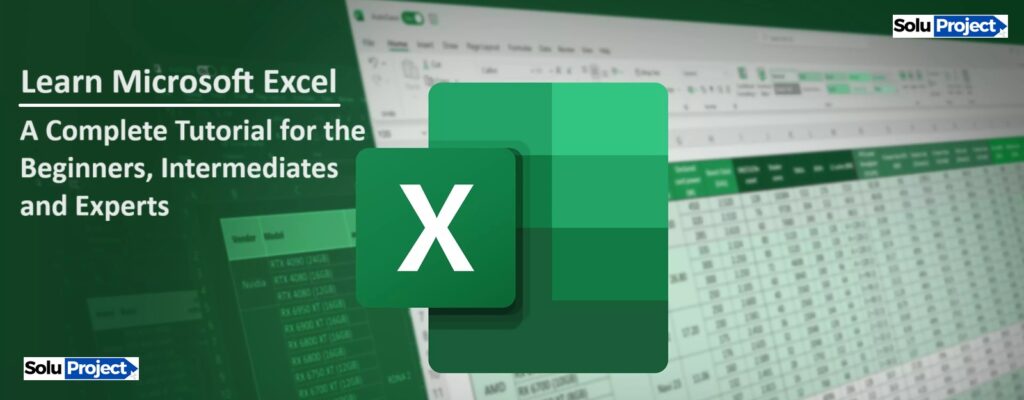
Learn Microsoft Excel and gain proficiency in this powerful spreadsheet program. With its extensive range of features and functions, Microsoft Excel is essential for data analysis, financial modeling, and project management. Enhance your skills and become proficient in this indispensable tool.
Let’s break down the Microsoft Excel tutorial into three steps for beginners, intermediates, and experts.
Step 1: Learn Microsoft Excel for Beginners
Click to Learn Microsoft Excel for Beginners in detail
1. Getting Started:
- Launch Excel and familiarize yourself with the user interface.
- Understand the basic components such as workbook, worksheet, rows, columns, and cells.
- Learn how to navigate through worksheets and workbooks.
2. Data Entry and Formatting:
- Enter data into cells and learn basic formatting options such as font style, size, and color.
- Format cells for numbers, dates, and text.
- Use basic formatting tools like bold, italic, underline, and alignment options.
3. Basic Formulas and Functions:
- Learn how to perform basic calculations using formulas (e.g., addition, subtraction, multiplication, division).
- Explore commonly used functions such as SUM, AVERAGE, MAX, MIN, and COUNT.
- Understand the concept of cell references (relative and absolute) and how they affect formulas.
4. Sorting and Filtering:
- Sort data in ascending or descending order based on a single column.
- Apply filters to quickly find and display specific data within a dataset.
5. Basic Charts and Graphs:
- Create simple charts like bar charts, line graphs, and pie charts to visualize data.
- Customize chart elements such as titles, axes, and legends.
- Understand when to use different types of charts based on the data you want to represent.
Click to Learn Microsoft Excel for Beginners in detail
Step 2: Learn Microsoft Excel for Intermediates
Click to Learn Microsoft Excel for Intermediates in detail
1. Advanced Formulas and Functions:
- Learn more advanced functions like VLOOKUP, HLOOKUP, INDEX-MATCH, IF statements, and nested functions.
- Explore logical functions such as IF, AND, OR, and NOT for more complex data analysis.
2. Data Analysis Tools:
- Master pivot tables to summarize, analyze, and manipulate large datasets.
- Use data validation to control the type of data entered into specific cells.
- Apply conditional formatting to highlight important trends or outliers in your data.
3. Advanced Charting Techniques:
- Create dynamic charts using named ranges and formulas.
- Customize chart elements further by adding trendlines, data labels, and secondary axes.
- Explore advanced chart types like combo charts and waterfall charts for more sophisticated data visualization.
4. Data Cleaning and Preparation:
- Use Excel’s built-in features like Text to Columns and Flash Fill to clean and transform messy data.
- Combine data from multiple sources using the CONCATENATE function or Excel’s Power Query tool.
Click to Learn Microsoft Excel for Intermediates in detail
Step 3: Learn Microsoft Excel for Experts
Click to Learn Microsoft Excel for Experts in detail
1. Macros and VBA:
- Learn to automate repetitive tasks using Excel macros.
- Dive into Visual Basic for Applications (VBA) to create custom functions, procedures, and user forms.
- Use VBA to interact with other Microsoft Office applications and external data sources.
2. Advanced Data Analysis Techniques:
- Perform regression analysis, scenario analysis, and Monte Carlo simulation using Excel’s built-in tools or custom VBA scripts.
- Utilize advanced statistical functions and add-ins for predictive modeling and forecasting.
3. Power Query and Power Pivot:
- Harness the power of Excel’s Power Query and Power Pivot tools to import, transform, and analyze large datasets from multiple sources.
- Create sophisticated data models and relationships to perform advanced data analysis and visualization.
4. Collaboration and Sharing:
- Explore Excel’s collaboration features such as co-authoring, comments, and sharing options to work on spreadsheets with colleagues in real-time.
- Learn how to protect and secure your Excel workbooks using password protection, encryption, and file permissions.
Click to Learn Microsoft Excel for Experts in detail
By following these three steps, beginners, intermediates, and experts can gradually enhance their skills and proficiency in Microsoft Excel, from basic data entry and formatting to advanced data analysis and automation techniques. To get video training, visit Microsoft Excel official website Excel video training – Microsoft Support.
Useful contents